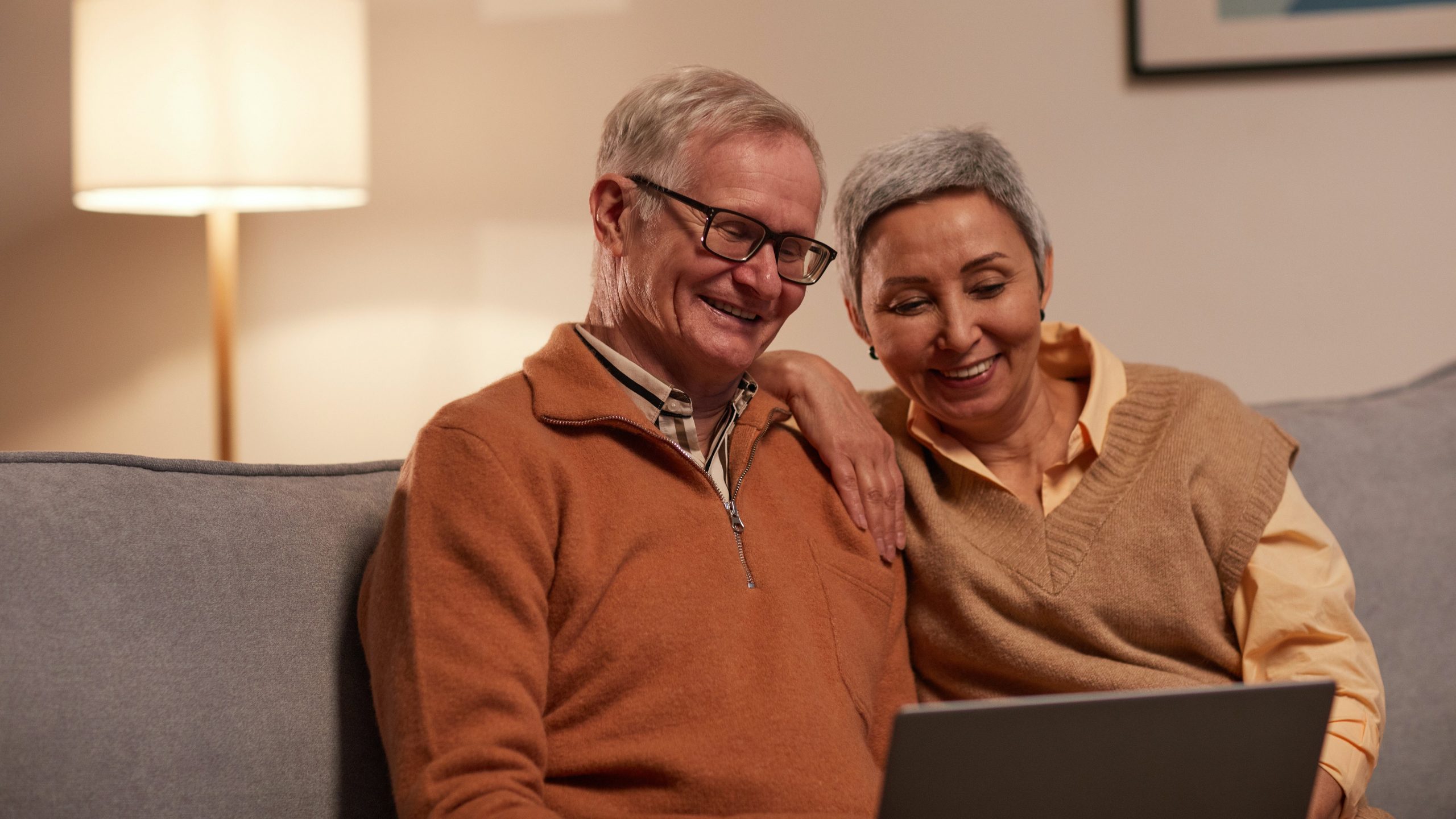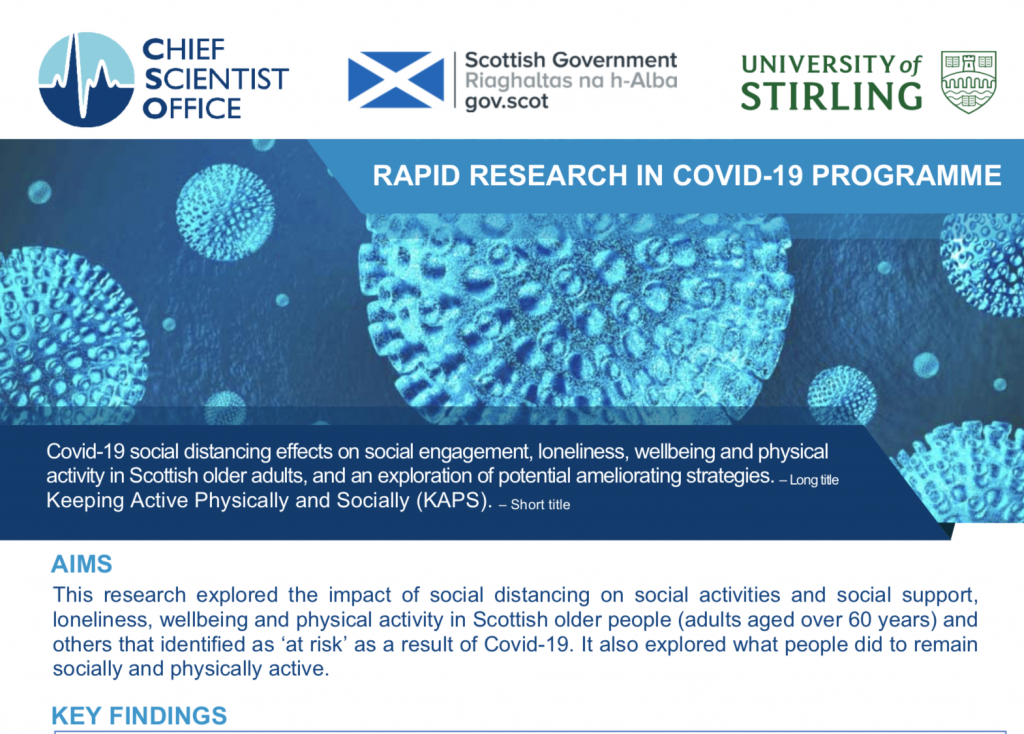Lockdown led to positive lifestyle changes in older people

The COVID-19 lockdown was a catalyst for many older people to embrace technology, reconnect with friends and build new relationships with neighbours, according to University of Stirling research.
Understanding the coping mechanisms adopted by some over 60s during the pandemic will play a key role in developing interventions to help tackle loneliness, isolation and wellbeing in the future.
The study, led by the Faculty of Health Sciences and Sport, surveyed 1,429 participants – 84 percent (1,198) of whom were over 60 – and found many had adapted to video conferencing technology to increase online contact with existing social networks, while others reconnected with previous networks. Participants reported that lockdown had led them to engage with neighbours and other members of their communities for the first time, while several said social distancing had brought an additional meaning to life, by highlighting what was important to them.
Published in the International Journal of Environmental Research and Public Health, the paper comes six months after the study – funded under the Scottish Government Chief Scientist Office’s Rapid Research in COVID-19 programme – reported in its preliminary findings that social distancing had increased feelings of loneliness in older people.
Professor of Behavioural Medicine, Anna Whittaker, who led the study, said: “Our research found that the COVID-19 lockdown triggered feelings of loneliness in older people – with many experiencing less social contact and support. However, the study also highlighted positive outcomes, for example, lockdown encouraged some older people to embrace and engage with technology – such as Zoom, Whatsapp or FaceTime – to stay in touch with loved-ones or participate in exercise classes or religious groups. Those who engaged in such activity were able to prevent high levels of loneliness, therefore, helping older adults to increase their digital literacy and use of remote social interactions could be a really important tool for addressing loneliness.
“Participants also reported actively looking for new social contact while restrictions were in place – such as contacting friends who they had not spoken to in years and increasing interactions with neighbours and other members of their communities. Significantly, many of our participants reported that social distancing has actually led them to find new sources of satisfaction in life.
“Our study also highlighted that encouraging safe social contact through physical activity and engaging with people in the community may be an effective way to reduce loneliness, improve wellbeing, increase social activity, and improve social support.”
The study – which involved a survey conducted between May and July 2020 – examined the impact of social distancing during the pandemic on loneliness, wellbeing and social activity, including social support, in Scottish older adults.
Participants were asked about the strategies they adopted to increase social interaction during this time and reported that the way they interacted with their friends and family, faith, chosen group activities and, to a lesser extent, their employer and colleagues, had changed. More than 300 participants mentioned ‘Zoom’ – the video conferencing tool – in their answers.
More than 150 participants reported that their religious gatherings had moved online – replacing face-to-face gatherings – while 91 said that social gatherings with family and friends had changed in favour of online ‘games nights’. New activities included bingo and quiz nights, while other activities moved online – such as bridge nights, book clubs, choir rehearsals, and dance and exercise classes.
The role of community – particularly neighbours – was mentioned by more than 300 participants and some reported the common experience of getting to know previously unknown neighbours and increase interaction with others in the community at local shops or parks. A pleasant Scottish summer also supported such interactions, several said.
At least 100 people said social interactions were linked to their physical activities – such as time spent outdoors while walking for exercise, walking the dogs or active commuting.
Professor Whittaker added: “Our research underlines the importance of addressing loneliness and social support in older adults – but particularly during situations where risk of isolation is high. Although specific to the pandemic, this study has wider implications of helping us to understand the impact of social distancing and social isolation on older people.
“The findings may be applicable in the future – both in and outwith pandemic situations. In Scotland, the recommendations for improvement may be through encouraging older adults to get to know their neighbours better, getting involved with local buddying systems and community initiatives, including via digital means, and engaging in physical activity, such as daily walks in the community.”
Brian Sloan, Chief Executive of Age Scotland, said: “While it may prove difficult to consider any aspect of the pandemic positive as such, it is important and worthwhile to reflect on what it has taught us, both about ourselves and society and about the necessary tools to tackle Scotland’s increased levels of loneliness and isolation.
“For example, we’ve seen first-hand how important the community response has been in terms of supporting older people throughout lockdown and it has been inspiring to witness how people across the country stepped in and stepped forward to help those in need around them. Even as restrictions ease, we hope to see this sense of community spirit continue.
“The ongoing impact of COVID-19 has also demonstrated just how important increased digital inclusion is and how easily those without access to technology can feel out of the loop. It’s reassuring to see so many older people reporting that they have been able to embrace and engage with technology to stay connected and active.
“However, it’s equally important to ensure those who are unable or do not wish to use the internet have alternative ways to stay connected to their communities and support networks.
“As we take steps towards recovery together, it is vital that no one is left behind and those most impacted are supported to play a full part in society again.
“We know we will be living with the ongoing effects of lockdown loneliness for a long time to come, and this research will be incredibly valuable when considering how best to tackle loneliness and isolation and to improve the wellbeing of older people going forward.”
Professor Whittaker was supported in the research by Stirling colleagues: Dr Simone Tomaz, Dr Pete Coffee, Dr Gemma Ryde, Bridgitte Swales, Dr Kacey Neely, Dr Jenni Connelly, Dr Andrew Kirkland, Dr Louise McCabe, Dr Karen Watchman, Dr Federico Andreis, Jack Martin, and Ilaria Pina.
- First posted 14 May 2021
Social distancing is increasing loneliness in older adults

Social distancing introduced in response to COVID-19 is increasing feelings of loneliness in Scotland’s older population and impacting their wellbeing, according to a new University of Stirling study.
The research has identified a link between increases in loneliness in over 60s and the worsening of wellbeing and health. Increasing loneliness due to social distancing was associated with a smaller social network, lower perceived social support and a decrease in wellbeing, the study found.
The findings emerge from research launched under the Scottish Government’s Chief Scientist Office Rapid Research in COVID-19 programme in May. Professor Anna Whittaker, of the University’s Faculty of Health Sciences and Sport, led the work and hopes it will help to inform decision-making on the virus and support post-pandemic recovery strategies.
Professor Whittaker said: “Previous studies have demonstrated the negative impacts of social isolation and loneliness. This is a key issue for older adults who may be more likely to have few social contacts. We know that social distancing guidelines introduced in response to COVID-19 have restricted social activity engagement and impacted vulnerable groups, including older adults.
“Our study, which involved a survey of more than 1,400 older people, examined the impact of social distancing during the pandemic on social activity, loneliness and wellbeing. The majority of survey participants reported that social distancing has made them experience more loneliness, social contact with fewer people, and less social contact overall.
“We found that a larger social network and better perceived social support seems to be protective against loneliness and poorer health and wellbeing, due to social distancing. This underlines the importance of addressing loneliness and social contact in older adults, but particularly during pandemics or situations where the risk of isolation is high.”
Of the 1,429 survey participants, 84 percent were aged 60 or over and had an average social network of five people. On average, the participants socialised five days per week, for more than 6.6 hours per week. Fifty-six percent reported that social distancing regulations made them experience more loneliness – with scores that were significantly higher than reported norms; the same quality of perceived support; but social contact with fewer people and less social contact overall.
Greater loneliness was significantly associated with a smaller social network, lower perceived social support, and a decrease in social support frequency, quality, and amount – and a worsening of wellbeing and health.
Professor Anna Whittaker
Physical activity engagement during lockdown varied and this study indicates a positive link with wellbeing – supporting the notion that physical activity should be considered an important contributor in recovery strategies targeted at older adults as we emerge from the pandemic.
Professor of Behavioural Medicine
Using the same survey data, the research also considered the impact of social distancing on physical activity. The majority of participants reported continuing to meet physical activity guidelines during lockdown – with 35 percent moderately active and 41 percent highly active. Walking was the greatest contributor to total physical activity, with just over a quarter (26.4%) walking more than before lockdown. Those living in rural areas reported greater volumes of physical activity.
Forty percent of people said they were walking less, compared to before lockdown, and a similar proportion were engaging in less moderate physical activity. Those who reported in engaging in lower physical activity had poorer wellbeing.
Individuals who reported no change in moderate physical activity were the most active pre-lockdown and those who reported no change in walking had significantly higher levels of total physical activity pre-lockdown.
Professor Whittaker said: “Physical activity engagement during lockdown varied and this study indicates a positive link with wellbeing – supporting the notion that physical activity should be considered an important contributor in recovery strategies targeted at older adults as we emerge from the pandemic.
“There appears to be a relationship between pre-lockdown physical activity and physical activity changes due to lockdown. This may be of significance in the context of trying to get older adults to maintain or increase physical activity, where appropriate, as we emerge from this pandemic, given our understanding of the benefits of physical activity in this age group.
“Additionally, irrespective of pre-lockdown physical activity, older adults should continue to be encouraged to be active, and particularly to engage in some sort of strength and balance training – such as tai chi, yoga, or weights – which was very low in the sample but is vital for maintaining balance and physical function. Just 12 percent of the sample met the physical activity guidelines, which indicate strength training should be undertaken at least twice per week.”
- First posted 9 November 2020
CSO Report of Key Findings
